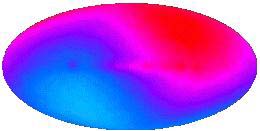It's a stretch
It's a stretch
Introduction
As the Universe Expands Light wavelengths increase
Material
A rubber band, at least 0.5 cm (0.25 inch) wide and as long as you can find.
A fine point pen
To Do and Notice
Draw a sine wave with a wavelength of 1 cm on the unstretched rubber band.
Measure the length of your rubber band.
Stretch the rubber band to twice its original length.
Notice what happens to the wavelength of the wave you have drawn.
When you double the length of the rubber band by stretching it, the wavelength of the sine wave also doubles.
![]()
![]()
Sinewave on a rubber band before and after it stretches.
What's Going On?
Light is a wave that travels through the vacuum of space.
When space expands so does the light that is traveling through the space.
If the distance between two clusters of galaxies doubles, the light traveling through the vacuum between these galaxy clusters doubles in wavelength.
So What?
The universe began with a big bang about 14 billion years ago. It was hotter and denser than it is now. It was so hot that all of the hydrogen atoms were ionized. The universe was a plasma, like the sun. And, like the sun the universe was opaque. After 300,000 years, or so, the universe cooled to 4000 K and electrons combined with protons to make hydrogen gas which is transparent. This time is called the era of recombination. Photons have traveled through the Universe since that time. They arrive at earth 14 billion years after starting their journey. While they are traveling the universe expands. Two points in the Universe move apart 1300 times further between the era of recombination and now. The wavelength of the light traveling through the universe expands by the same amount. The light is red shifted by the expansion of the universe. Light emitted just before the Universe goes transparent is at 4000K and has a wavelength which is seen as orange, 600 nm. This wavelength is stretched 1300 times, and today, it is a millimeter.
Going Further
When Hubble first looked at distant galaxies and saw that the light coming from them was red shifted he attributed the red shift purely to the motion of those galaxies away from us, their velocity through space, the Doppler redshift.
Today we have a more subtle model. We say that space itself is expanding and the galaxies are carried along with the expanding space. The redshift due to the expansion of the space is called the cosmological redshift.

The whole sky viewed in the microwave region of the spectrum. We are moving toward the big bang where this image is colored blue and away from it where it is colored red.
The redshift of distant galaxies is due to expansion of the universe not to the Doppler shift.
When Hubble first discovered the expansion of the universe he explained the red shift of the light from distant galaxies as a Doppler shift produced by their motion. Today astronomers say that the redshift is not due to the Doppler shift it is due to the expansion of space itself.
The above image shows one reason for the switch. It shows that the Milky Way galaxy is moving through space with respect to the big bang at 600 km/s producing a redshift behind us and a blueshift in front. Imagine leaving the Milky Way and heading in the opposite direction at 600 km/s the big bang would no longer show a pattern of redshift/blueshift. We would be at rest with respect to the big bang. Now imagine a distant galaxy an observer in that galaxy looks around and sees that there is no redshift/blueshift of the radiation from the big bang. They are at rest as well. Yet, when each of these galaxies which is at rest with respect to the frame of reference of the big bang look at each other they see a redshift! This redshift is the cosmological redshift. It occurs because while a photon is in transit from one galaxy to another it moves through space which is expanding. If the galaxies were moving with respect to the big bang then they would show a Doppler shift in addition to this cosmological redshift.
Many scientists still speak of the redshift as a Doppler shift however so watch out.
|
Scientific Explorations with Paul Doherty |
|
15 Jan 2001 |